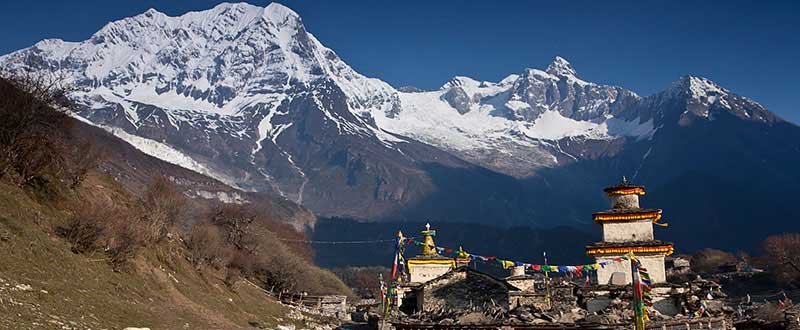Manaslu Region Trek-a detailed guide

- 07-Jul-2018
- 0
Are you planning to trek Manaslu Region?
Regarded as one of the pre-eminent trekking destinations on the entire planet, the Manaslu region Trek has been widely celebrated in recent years due to the unique natural and cultural heritage it possesses. The name Manaslu has its origins in the Sanskrit word Manasa which translates into “Mountain of the Spirit.” Positioned in the Gorkha District of Nepal, Manaslu is praised as a “wall of snow and ice hanging in the sky” and puts forward an unsurpassed window of opportunity to acquire a detailed insight of justifiably “untouched” territory.
The Manaslu Circuit was unlocked for trekkers in 1991 A.D. Since trekkers were compelled to manage their necessities such as food and water themselves due to the lack of teahouses and necessary infrastructures, the Manaslu region was initially renowned for camping treks. Porters for hire were also available to make trekking in this region even more expensive. Though at present times, several tea-houses and lodges are open for business at several points alongside trekking trails that have made trekking easier and relatively cheaper. Thanks to its trekking trails which have been neglected and untouched for a long period, trekkers are bestowed with a classic trekking experience. Mt Manaslu, standing at the elevation of 8,156m is the 8th highest mountain in the world, which becomes visible as you trek across the region. Natives believe Mt. Manaslu to be inhabited by spiritual deities. It is supposed that “just as the British consider Everest their mountain, Manaslu has always been a Japanese mountain.”
The diverse and isolated trekking routes of the Manaslu region originate at around 1,000 meters and reach as high as 5,200m asl, where trekkers can discover a variety of flora, mainly pine, bamboo, and rhododendron i.e., particular to the middle hills and alpine regions of Nepal. Additionally, wildlife including barking deer, Pika, and Himalayan marmots accompanied by birds such as are pheasant, raven, and chough are occupants of this diverse woodland. Apart from these, the Manaslu trek showcases enthralling landscapes and panoramic vistas comprising majestic mountains encompassing Mt. Manaslu, Mount Himalchuli, Ngadi Chuli, and Ganesh Himal mountains range, parallel to snowy summits of Shringi, Langpo, and Saula. The other highlights of this region include Lhargyal La Pass, Tsum Valley, and Nupri Valley.
Lhargyal La translates into victory hill or victory pass. The Pass is situated at an altitude of 5,220m, the highest point of the Manaslu Circuit Trek. The apex of Lhargyal La is adorned with delightful Buddhist prayer flags and extends the awe-inspiring outlooks of Himlung Himal, Cheo Himal, Kang Guru, and Annapurna II. Likewise, Tsum Valley functions as the crown jewel of the Manaslu region. Located in northern Gorkha, the sacred valley flaunts exquisite outlooks of Ganesh Himal and Sringi Himal, next to Himal Boudha ranges. To be precise, Tsum is a Tibetan word that translates into vivid. The name is undisputedly appropriate for this picturesque Himalayan valley because of its graceful classic art, culture, and traditions, chiefly inspired by Buddhism. Moreover, most of the native population belongs to Tibetan origin and speaks a distinct dialect. On top of that, the Manaslu region is home to Nupri Valley based in Upper Budi Gandaki. Their residents are descendants of Tibetan immigrants and share the same speech, dress, and customs as their contemporary Tibetan counterparts.
Rules and Permits
As the Manaslu region falls under Manaslu Conservation Area, all trekking activities within the Manaslu Circuit are monitored by the government of Nepal and its local bodies to preserve its natural resources and cultural heritage. Therefore, you will require a permit to explore the area. Depending on the month and number of days you will spend in this region, the permit cost for Manaslu Trek varies. You will need three kinds of permits issued by the Government of Nepal to backpack within the vicinity of the Manaslu region. Furthermore, the rules utterly explain that you’ll require a pack of a minimum of 2 people plus a registered guide. Nonetheless, you will require a second permit of a “ghost” trekker, if you desire to trek alone; for that, you are obliged to have an actual passport which is difficult. Another alternative is to attach with a group up to Jagat then bid a pre-arranged farewell. Apart from the original passport along with its copies, you’ll be under the compulsion to have four Passport-sized photos to acquire a valid permit. Double-check everything before you go!!!
The check-in point is based in Jagat while the check-out point is placed in Dharapani.
Manaslu Restricted Permit
Manaslu trek permit costs USD 100.00 for the first seven days and USD 15.00 each additional day from September to November.
Manaslu trek permit costs USD 75.00 for the first 7 days and USD 10.00 each extra day from December to August.
Manaslu Conservation Area Permit (MCAP)
The entry fee for SAARC Nationals is NPR. 300 per individual; whereas, NPR. 3,000 per individual for other Nationals.
Annapurna Conservation Area Permit (ACAP)
The entry fee for SAARC Nationals is NPR. 300 per individual; whereas, NPR. 3,000 per individual for other Nationals.
Tsum Valley Restricted Permit (Optional: if you wish to explore Tsum Valley)
Days in Tsum Valley restricted permit is independent of your Manaslu permit. If you settle the Tsum Valley trek, it will cost you USD 40 each individual per week. Beyond the week, USD 7 per day per person.
TIMS (Trekkers' Information Management System) Card
As per the recent MoU signed by NTB and TAAN, the TIMS card is applicable in all trekking areas of the country including restricted areas:
Group trekkers (Blue TIMS cards):
SAARC countries: NPR. 300. per person
Other than SAARC countries: NPR. 1,000 per person
FITs (Free Individual Trekkers) (Green TIMS cards):
SAARC countries: NPR. 600
Other than SAARC countries: NPR. 2000
Want to live the Manaslu fantasy?? Then, contact us right now and turn your dream into reality!!!




